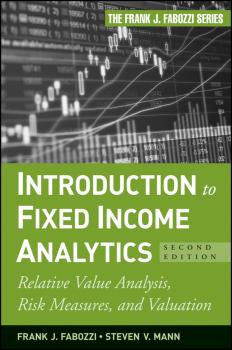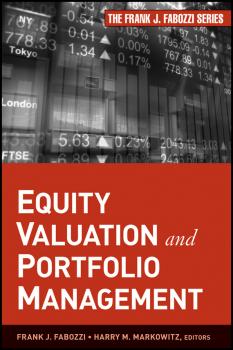ТОП просматриваемых книг сайта:
Frank Fabozzi J.
Список книг автора Frank Fabozzi J.Аннотация
An up-to-date look at the latest innovations in mortgage-backed securities Since the last edition of Mortgage-Backed Securities was published over three years ago, much has changed in the structured credit market. Frank Fabozzi, Anand Bhattacharya, and William Berliner all have many years of experience working in the fixed-income securitization markets, and have witnessed many cycles of change in the mortgage and MBS sectors. And now, with the Second Edition of Mortgage-Backed Securities, they share their knowledge on many of the products and structuring innovations that have taken place since the financial crisis and fiscal reform. Written in a straightforward and accessible style, and containing numerous illustrations, this timely guide skillfully addresses the investment characteristics, creation, and analysis of mortgage-backed securities. Each chapter contains cutting-edge concepts that you'll need to understand in order to thrive within this arena. Discusses the dynamic interaction between the mortgage industry, home prices, and credit performance Addresses revised valuation techniques in which all non-agency MBS must be treated as credit pieces Examines the shift in this marketplace since the crisis and the impact on industry and investors Filled with in-depth insights and expert advice, Mortgage-Backed Securities, Second Edition offers you a realistic assessment of this field and outlines the products, structures, and analytical techniques you need to know about in this evolving arena.
Introduction to Fixed Income Analytics. Relative Value Analysis, Risk Measures and Valuation - Frank Fabozzi J.
Аннотация
A comprehensive introduction to the key concepts of fixed income analytics The First Edition of Introduction to Fixed Income Analytics skillfully covered the fundamentals of this discipline and was the first book to feature Bloomberg screens in examples and illustrations. Since publication over eight years ago, the markets have experienced cathartic change. That's why authors Frank Fabozzi and Steven Mann have returned with a fully updated Second Edition. This reliable resource reflects current economic conditions, and offers additional chapters on relative value analysis, value-at-risk measures and information on instruments like TIPS (treasury inflation protected securities). Offers insights into value-at-risk, relative value measures, convertible bond analysis, and much more Includes updated charts and descriptions using Bloomberg screens Covers important analytical concepts used by portfolio managers Understanding fixed-income analytics is essential in today's dynamic financial environment. The Second Edition of Introduction to Fixed Income Analytics will help you build a solid foundation in this field.
Аннотация
A comprehensive look at the tools and techniques used in quantitative equity management Some books attempt to extend portfolio theory, but the real issue today relates to the practical implementation of the theory introduced by Harry Markowitz and others who followed. The purpose of this book is to close the implementation gap by presenting state-of-the art quantitative techniques and strategies for managing equity portfolios. Throughout these pages, Frank Fabozzi, Sergio Focardi, and Petter Kolm address the essential elements of this discipline, including financial model building, financial engineering, static and dynamic factor models, asset allocation, portfolio models, transaction costs, trading strategies, and much more. They also provide ample illustrations and thorough discussions of implementation issues facing those in the investment management business and include the necessary background material in probability, statistics, and econometrics to make the book self-contained. Written by a solid author team who has extensive financial experience in this area Presents state-of-the art quantitative strategies for managing equity portfolios Focuses on the implementation of quantitative equity asset management Outlines effective analysis, optimization methods, and risk models In today's financial environment, you have to have the skills to analyze, optimize and manage the risk of your quantitative equity investments. This guide offers you the best information available to achieve this goal.
Аннотация
A detailed look at equity valuation and portfolio management Equity valuation is a method of valuing stock prices using fundamental analysis to determine the worth of the business and discover investment opportunities. In Equity Valuation and Portfolio Management Frank J. Fabozzi and Harry M. Markowitz explain the process of equity valuation, provide the necessary mathematical background, and discuss classic and new portfolio strategies for investment managers. Divided into two comprehensive parts, this reliable resource focuses on valuation and portfolio strategies related to equities. Discusses both fundamental and new techniques for valuation and strategies Fabozzi and Markowitz are experts in the fields of investment management and economics Includes end of chapter bullet point summaries, key chapter take-aways, and study questions Filled with in-depth insights and practical advice, Equity Valuation and Portfolio Management will put you in a better position to excel at this challenging endeavor.
Аннотация
The fully update Third Edition of the most trusted book on financial statement analysis Recent financial events have taught us to take a more critical look at the financial disclosures provides by companies. In the Third Edition of Analysis of Financial Statements, Pamela Peterson-Drake and Frank Fabozzi once again team up to provide a practical guide to understanding and interpreting financial statements. Written to reflect current market conditions, this reliable resource will help analysts and investors use these disclosures to assess a company's financial health and risks. Throughout Analysis of Financial Statements, Third Edition, the authors demonstrate the nuts and bolts of financial analysis by applying the techniques to actual companies. Along the way, they tackle the changing complexities in the area of financial statement analysis and provide an up-to-date perspective of new acts of legislation and events that have shaped the field. Addresses changes to U.S. and international accounting standards, as well as innovations in the areas of credit risk models and factor models Includes examples, guidance, and an incorporation of information pertaining to recent events in the accounting/analysis community Covers issues of transparency, cash flow, income reporting, and much more Whether evaluating a company's financial information or figuring valuation for M&A's, analyzing financial statements is essential for both professional investors and corporate finance executives. The Third Edition of Analysis of Financial Statements contains valuable insights that can help you excel at this endeavor.
Аннотация
A detailed, multi-disciplinary approach to investment analytics Portfolio Construction and Analytics provides an up-to-date understanding of the analytic investment process for students and professionals alike. With complete and detailed coverage of portfolio analytics and modeling methods, this book is unique in its multi-disciplinary approach. Investment analytics involves the input of a variety of areas, and this guide provides the perspective of data management, modeling, software resources, and investment strategy to give you a truly comprehensive understanding of how today's firms approach the process. Real-world examples provide insight into analytics performed with vendor software, and references to analytics performed with open source software will prove useful to both students and practitioners. Portfolio analytics refers to all of the methods used to screen, model, track, and evaluate investments. Big data, regulatory change, and increasing risk is forcing a need for a more coherent approach to all aspects of investment analytics, and this book provides the strong foundation and critical skills you need. Master the fundamental modeling concepts and widely used analytics Learn the latest trends in risk metrics, modeling, and investment strategies Get up to speed on the vendor and open-source software most commonly used Gain a multi-angle perspective on portfolio analytics at today's firms Identifying investment opportunities, keeping portfolios aligned with investment objectives, and monitoring risk and performance are all major functions of an investment firm that relies heavily on analytics output. This reliance will only increase in the face of market changes and increased regulatory pressure, and practitioners need a deep understanding of the latest methods and models used to build a robust investment strategy. Portfolio Construction and Analytics is an invaluable resource for portfolio management in any capacity.
Investing in Mortgage-Backed and Asset-Backed Securities. Financial Modeling with R and Open Source Analytics - Frank Fabozzi J.
Аннотация
A complete guide to investing in and managing a portfolio of mortgage- and asset-backed securities Mortgage- and asset-backed securities are not as complex as they might seem. In fact, all of the information, financial models, and software needed to successfully invest in and manage a portfolio of these securities are available to the investment professional through open source software. Investing in Mortgage and Asset-Backed Securities + Website shows you how to achieve this goal. The book draws entirely on publicly available data and open source software to construct a complete analytic framework for investing in these securities. The analytic models used throughout the book either exist in the quantlib library, as an R package, or are programmed in R and incorporated into the analytic framework used. Examines the valuation of fixed-income securities—metrics, valuation framework, and return analysis Covers residential mortgage-backed securities—security cash flow, mortgage dollar roll, adjustable rate mortgages, and private label MBS Discusses prepayment modeling and the valuation of mortgage credit Presents mortgage-backed securities valuation techniques—pass-through valuation and interest rate models Engaging and informative, this book skillfully shows you how to build, rather than buy, models and proprietary analytical platforms that will allow you to invest in mortgage- and asset-backed securities.







